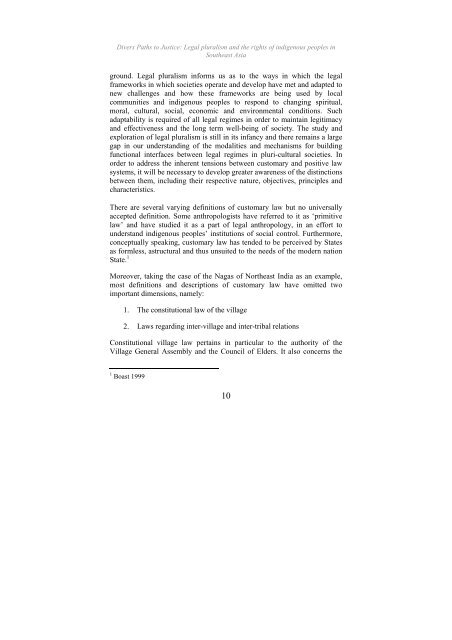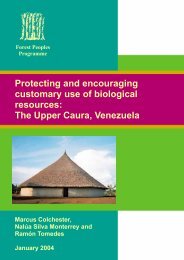Divers Paths to Justice - English - Forest Peoples Programme
Divers Paths to Justice - English - Forest Peoples Programme
Divers Paths to Justice - English - Forest Peoples Programme
Create successful ePaper yourself
Turn your PDF publications into a flip-book with our unique Google optimized e-Paper software.
<strong>Divers</strong> <strong>Paths</strong> <strong>to</strong> <strong>Justice</strong>: Legal pluralism and the rights of indigenous peoples inSoutheast Asiaground. Legal pluralism informs us as <strong>to</strong> the ways in which the legalframeworks in which societies operate and develop have met and adapted <strong>to</strong>new challenges and how these frameworks are being used by localcommunities and indigenous peoples <strong>to</strong> respond <strong>to</strong> changing spiritual,moral, cultural, social, economic and environmental conditions. Suchadaptability is required of all legal regimes in order <strong>to</strong> maintain legitimacyand effectiveness and the long term well-being of society. The study andexploration of legal pluralism is still in its infancy and there remains a largegap in our understanding of the modalities and mechanisms for buildingfunctional interfaces between legal regimes in pluri-cultural societies. Inorder <strong>to</strong> address the inherent tensions between cus<strong>to</strong>mary and positive lawsystems, it will be necessary <strong>to</strong> develop greater awareness of the distinctionsbetween them, including their respective nature, objectives, principles andcharacteristics.There are several varying definitions of cus<strong>to</strong>mary law but no universallyaccepted definition. Some anthropologists have referred <strong>to</strong> it as ‘primitivelaw’ and have studied it as a part of legal anthropology, in an effort <strong>to</strong>understand indigenous peoples’ institutions of social control. Furthermore,conceptually speaking, cus<strong>to</strong>mary law has tended <strong>to</strong> be perceived by Statesas formless, astructural and thus unsuited <strong>to</strong> the needs of the modern nationState. 1Moreover, taking the case of the Nagas of Northeast India as an example,most definitions and descriptions of cus<strong>to</strong>mary law have omitted twoimportant dimensions, namely:1. The constitutional law of the village2. Laws regarding inter-village and inter-tribal relationsConstitutional village law pertains in particular <strong>to</strong> the authority of theVillage General Assembly and the Council of Elders. It also concerns the1 Boast 199910
















